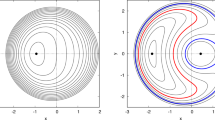Abstract
A study of the behavior of axisymmetric structures is important for understanding the problem of the existence and stability of planet rings, spherical star constellations, and galaxies. The multilayer ring structure algorithm is developed on the basis of an exact solution to the problem of n-body gravitational axisymmetric interaction. As a result of the numerical integration of differential motion equations of point bodies composing the above structures, the evolution of several of their models is investigated. Some of them are invariable in configuration, others change forms due to interlayer interactions, and the rest throw part of bodies out of the structure.
Similar content being viewed by others
References
E. A. Grebenikov, D. Kozak-Skovorodkina, and M. Yakubyak, Computer Algebra Methods in a Many-Body Problem (Ross. Univ. Druzhby Narodov, Moscow, 2002) [in Russian].
E. V. Ikhsanov, The Computer Methods of Hamiltonian Normalization for Restricted Problems of Celestial Mechanics (Ross. Univ. Druzhby Narodov, Moscow, 2002) [in Russian].
N. I. Zemtsova and D. Kozak-Skovorodkina, “Stability Problem of Stationary Solutions of Restricted Problem of 12 Bodies with Incomplete Symmetry in the Case of Frequency Third Order Resonance,” in Theoretical and Applied Problems of Nonlinear Analysis (Vych. Tsentr RAN Dorordnitsyna, Moscow, 2006), pp. 77–90 [in Russian].
E. A. Grebenikov, D. D. Diarova, and N. N. Zemtsova, “Existence and Instability of Diamond-Like Central Configurations in Wintner Sense for Newton Model of 9 Bodies,” in Theoretical and Applied Problems of Nonlinear Analysis (Vych. Tsentr RAN Dorordnitsyna, Moscow, 2006), pp. 65–77 [in Russian].
B. Elmabsout, “Stability of Some Degenerate Positions of Relative Equilibrium in the N-Body Problem,” Dynam. Stabil. Syst. 9, 305–319 (1994).
E. A. Grebenikov, “Existence of Precise Symmetric Solutions in Flat Newton Many-Body Problem,” Matem. Model. 10(8), 74–80 (1998).
V. D. Gutsu, D. M. Diarova, and N. I. Zemtsova, “Study of Stability of Stationary Solutions of Diamond-Like Restricted 10-Body Problem,” in Theoretical and Applied Problems of Nonlinear Analysis (Vych. Tsentr RAN Dorordnitsyna, Moscow, 2007), pp. 99–109 [in Russian].
I. I. Smul’skii, “Construirovanie kol’tsevykh struktur,” in Fundamental and Applied Problems of Modern Mechanics, Proceedings of the 6th All-Russia Scientific Conference Dedicated to 130 Years of Tomsk State University and 40 Years of Institute of Applied Mathematics and Mechanics of Tomsk State University, Tomsk, 30 Sept.–2 Oct., 2008 (Tomsk, 2008), pp. 431–432.
I. I. Smul’skii, “Axisymmetric Problem of Gravitational Interaction of N-Bodies,” Matem. Model. 15(5), 27–36 (2003), http://www.smul1.newmail.ru/Russian1/IntSun-Syst/Osvnb4.doc.
I. I. Smul’skii, Interaction Theory (Novosib. Univ., NNTs OIGGM SO RAN, Novosibirsk, 1999) [in Russian], http: // www.ikz.ru/~smulski/TVfulA5-2.pdf.
E. A. Grebenikov and I. I. Smul’skii, Evolution of the Mars Orbit on Time Span in Hundred Millions Years, Report on Applied Mathematics (Vych. Tsentr RAN Dorodnitsyna, Moscow, 2007) [in Russian], http: // www.ikz.ru/~smulski/Papers/EvMa100m4t2.pdf.
Author information
Authors and Affiliations
Rights and permissions
About this article
Cite this article
Smul’skii, I.I. Multilayer ring structures. Phys. Part. Nuclei Lett. 8, 436–440 (2011). https://doi.org/10.1134/S1547477111050189
Published:
Issue Date:
DOI: https://doi.org/10.1134/S1547477111050189




